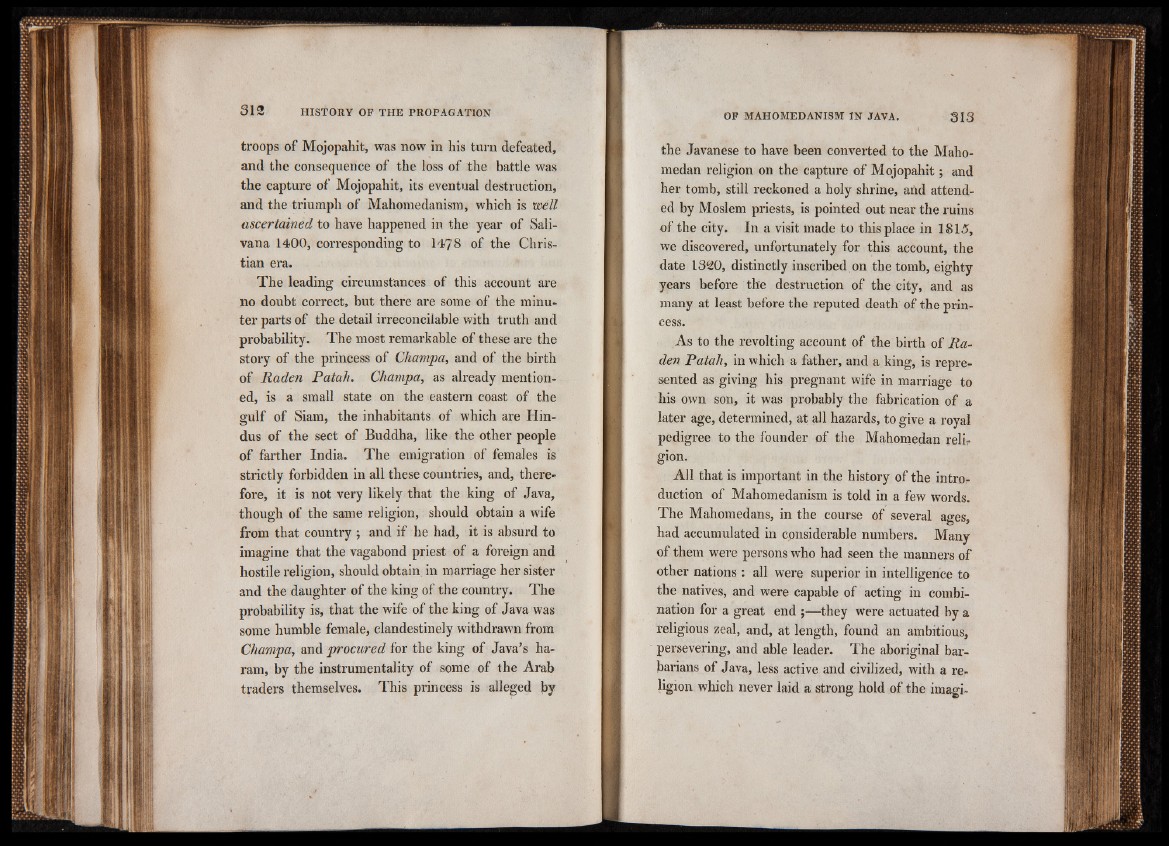
troops of Mojopahit, was now in his turn defeated,
and the consequence of the loss of the battle was
the capture of Mojopahit, its eventual destruction,
and the triumph of Mahomedanism, which is well
ascertained to have happened in the year of Sali-
vana 1400, corresponding to 1478 of the Christian
era.
The leading circumstances of this account are
no doubt correct, but there are some of the minuter
parts of the detail irreconcilable with truth and
probability. The most remarkable of these are the
story of the princess of Champa, and of the birth
of Raden Patah. Champa, as already mentioned,
is a small state on the eastern coast of the
gulf of Siam, the inhabitants of which are Hindus
of the sect of Buddha, like the other people
of farther India. The emigration of females is
strictly forbidden in all these countries, and, therefore,
it is not very likely that the king of Java,
though of the same religion, should obtain a wife
from that country j and if he had, it is absurd to
imagine that the vagabond priest of a foreign and
hostile religion, should obtain in marriage her sister
and the daughter of the king of the country. The
probability is, that the wife of the king of Java was
some humble female, clandestinely withdrawn from
Champa, and procured for the king of Java’s ha-
ram, by the instrumentality of some of the Arab
traders themselves. This princess is alleged by
the Javanese to have been converted to the Maho-
medan religion on the capture of Mojopahit; and
her tomb, still reckoned a holy shrine, and attended
by Moslem priests, is pointed out near the ruins
of the city. In a visit made to this place in 1815,
we discovered, unfortunately for this account, the
date 1320, distinctly inscribed on the tomb, eighty
years before the destruction of the city, and as
many at least before the reputed death of the princess
.A
s to the revolting account of the birth of Raden
Patah, in which a father, and a king, is represented
as giving his pregnant wife in marriage to
his own son, it was probably the fabrication of a
later age, determined, at all hazards, to give a royal
pedigree to the founder of the Mahomedan relir
gion.
All that is important in the history of the introduction
of Mahomedanism is told in a few words.
The Mahomedans, in the course of several ages,
had accumulated in considerable numbers. Many
of them were persons who had seen the manners of
other nations: all were superior in intelligence to
the natives, and were capable of acting in combination
for a great end ;—they were actuated by a
religious zeal, and, at length, found an ambitious,
persevering, and able leader. The aboriginal barbarians
of Java, less active and civilized, with a rer
ligion which never laid a strong hold of the imagi